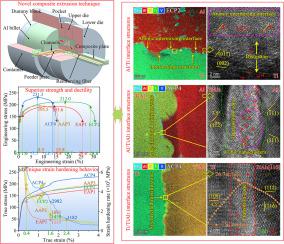当前位置:
X-MOL 学术
›
Int. J. Plasticity
›
论文详情
Our official English website, www.x-mol.net, welcomes your
feedback! (Note: you will need to create a separate account there.)
Enhancing strength and ductility of extruded Ti-alloy-reinforced Al-Mg-Si composites: Roles of interface nanostructures and chemical bonding
International Journal of Plasticity ( IF 9.4 ) Pub Date : 2024-05-19 , DOI: 10.1016/j.ijplas.2024.104009 Mingfu Liu , Cunsheng Zhang , Zijie Meng , Zhenyu Liu , Liang Chen , Guoqun Zhao
International Journal of Plasticity ( IF 9.4 ) Pub Date : 2024-05-19 , DOI: 10.1016/j.ijplas.2024.104009 Mingfu Liu , Cunsheng Zhang , Zijie Meng , Zhenyu Liu , Liang Chen , Guoqun Zhao

|
A comprehensive understanding of interface nanostructures and chemical interactions is required for solving the strength-plasticity trade-off dilemma of Al/Ti composites. Continuously Ti-reinforced Al-matrix composites with superior strength and ductility are fabricated via a novel extrusion technique. The unique strain-hardening mechanism of the Al/Ti composite plates at low strains is attributed to the coupling effects of the strong interface constraint potency, the mechanical incompatibility between the soft Al and hard α-Ti, and a large elastic strain of hard α-Ti. Interlocking structures with atomic interdiffusion are observed at the Al/Ti interface. Mechanical and thermal effects induce lattice distortion and atomic superdiffusion, thus resulting in an interfacial intermixing zone with substantial dislocations and misfit strain. These characteristics produce a strong interface constraint effect during tensile, causing superior strain/dislocation hardening and uniform plasticity. Nanoclusters with cubic structures and dispersed dislocations are detected in the three-dimensional (3D) atomic intermixing zone at the Al/TiAl interface, accompanied by the aggregation of Mg. The nanostructures with numerous dislocations in the 3D Ti/TiAl transition zone feature lattices with partially tetragonal structures and ordered Ti-Al(Si) clusters. calculations indicate that the strong chemical interaction between Si and Ti atoms not only improves the interface bonding strength, but also disturbs the lattices and broadens the transition zone. Moreover, the 3D interface transition zones, accompanied by dispersed dislocations, improve the interface constraint potency and hardening capability of the annealed Al/Ti composite plate. This work sheds light on the capability of the extrusion technique to produce fiber-reinforced Al-matrix composites with superior mechanical properties and provides new strategies for improving the chemical bonding strength and interface constraint effect via the interface invasion of specific elements.
中文翻译:

提高挤压钛合金增强 Al-Mg-Si 复合材料的强度和延展性:界面纳米结构和化学键合的作用
要解决 Al/Ti 复合材料的强度-塑性权衡困境,需要全面了解界面纳米结构和化学相互作用。通过新颖的挤压技术制造出具有优异强度和延展性的连续钛增强铝基复合材料。 Al/Ti复合板在低应变下独特的应变硬化机制归因于强界面约束力、软Al和硬α-Ti之间的机械不相容性以及硬α-Ti的大弹性应变的耦合效应-钛。在 Al/Ti 界面处观察到具有原子相互扩散的联锁结构。机械和热效应引起晶格畸变和原子超扩散,从而产生具有大量位错和失配应变的界面混合区。这些特性在拉伸过程中产生强大的界面约束效应,从而产生优异的应变/位错硬化和均匀的塑性。在 Al/TiAl 界面的三维 (3D) 原子混合区中检测到具有立方结构和分散位错的纳米团簇,并伴随着 Mg 的聚集。 3D Ti/TiAl 过渡区中具有大量位错的纳米结构具有部分四方结构和有序 Ti-Al(Si) 簇的晶格。计算表明,Si和Ti原子之间强烈的化学相互作用不仅提高了界面结合强度,而且扰乱了晶格并加宽了过渡区。此外,3D界面过渡区伴随着分散的位错,提高了退火Al/Ti复合板的界面约束能力和硬化能力。 这项工作揭示了挤压技术生产具有优异机械性能的纤维增强铝基复合材料的能力,并为通过特定元素的界面侵入提高化学键合强度和界面约束效应提供了新策略。
更新日期:2024-05-19
中文翻译:

提高挤压钛合金增强 Al-Mg-Si 复合材料的强度和延展性:界面纳米结构和化学键合的作用
要解决 Al/Ti 复合材料的强度-塑性权衡困境,需要全面了解界面纳米结构和化学相互作用。通过新颖的挤压技术制造出具有优异强度和延展性的连续钛增强铝基复合材料。 Al/Ti复合板在低应变下独特的应变硬化机制归因于强界面约束力、软Al和硬α-Ti之间的机械不相容性以及硬α-Ti的大弹性应变的耦合效应-钛。在 Al/Ti 界面处观察到具有原子相互扩散的联锁结构。机械和热效应引起晶格畸变和原子超扩散,从而产生具有大量位错和失配应变的界面混合区。这些特性在拉伸过程中产生强大的界面约束效应,从而产生优异的应变/位错硬化和均匀的塑性。在 Al/TiAl 界面的三维 (3D) 原子混合区中检测到具有立方结构和分散位错的纳米团簇,并伴随着 Mg 的聚集。 3D Ti/TiAl 过渡区中具有大量位错的纳米结构具有部分四方结构和有序 Ti-Al(Si) 簇的晶格。计算表明,Si和Ti原子之间强烈的化学相互作用不仅提高了界面结合强度,而且扰乱了晶格并加宽了过渡区。此外,3D界面过渡区伴随着分散的位错,提高了退火Al/Ti复合板的界面约束能力和硬化能力。 这项工作揭示了挤压技术生产具有优异机械性能的纤维增强铝基复合材料的能力,并为通过特定元素的界面侵入提高化学键合强度和界面约束效应提供了新策略。











































 京公网安备 11010802027423号
京公网安备 11010802027423号